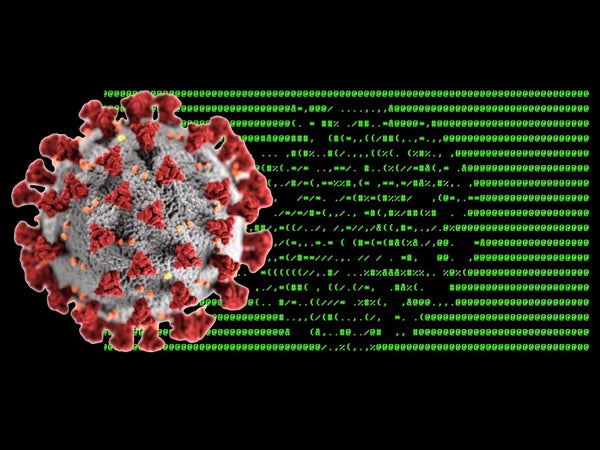The ongoing coronavirus pandemic might not seem like an obvious cue for thinking about biological transcendence. But the strange thing is that in our response to this crisis we’ve been unwitting participants in just such an event.
The idea of transcendence goes back a long way, under a variety of names and guises. In many religions it captures the notion of deities or phenomena that exist somehow independently of the physical universe and even beyond physical laws. Philosophers like Immanuel Kant modified aspects of this concept and created a label for things that are literally unknowable and that exist outside of knowledge itself.
But in recent times transcendence has become associated with the notion of humans going beyond our default form of consciousness; often conflated with the mystical idea of “ascendance” to some higher form of existence—a trope eagerly adopted by scores of not-really-trying-very-hard science fiction stories, movies and futurists. Most of the slightly more-grounded versions of these speculations see humans and machines melding into something new. Maybe our consciousnesses and memories—our “self”—could be uploaded to immortal digital form, swirling around the internet or in some omnipotent supercomputer.
On supporting science journalism
If you're enjoying this article, consider supporting our award-winning journalism by subscribing. By purchasing a subscription you are helping to ensure the future of impactful stories about the discoveries and ideas shaping our world today.
These fantasies are quite alluring (and they really are fantasies at this point; we don’t understand consciousness or the full physical basis of memory and behavior, so the odds of mapping “you” into a machine seem pretty slim). They’re also a great distraction from the surprising and very real examples of such transformations that are happening right now, under our noses.
Take the novel coronavirus SARS-Cov-2. Its genetic material is a single strand of RNA with 29,903 nucleotides (the “letters” of the genetic code common to all known life on Earth) that contain information for about 30 genes for making proteins. (A virus is “simply a piece of bad news wrapped up in protein,” in words that have been attributed to biologists Peter and Jean Medawar.)
Whatever the precise origin of this specific type of coronavirus, the informational content of that strand of RNA had, until early 2020, never existed in the world in any other form than the polymerized nucleotides of biochemistry. Every single copy of SARS-Cov-2 was a bundle of molecules and nothing more. But then, almost overnight, it jumped to an entirely new substrate.
Starting from the innards of PCR sequencing systems and technology like nanopore devices (that literally pull a strand of DNA or RNA through a molecular sensor that registers different electrical charges for different nucleotides) the viral RNA was converted into digital data; symbolic representations that are themselves encoded as tiny electrical or magnetic bits in silicon memory or hard drives. From here the informational content of the viral RNA was duplicated: across storage devices, through the internet, into cloud servers, onto people’s laptops, cell phones, flash drives and to some extent into their brains as trained researchers pored over the gene sequences and their associated molecular machinery.
This viral transcendence hasn’t just stopped at the replication of symbolic information though. That same information now interacts with the world in ways that it couldn’t when locked up in viral RNA. Now it influences human activity and behavior. We run computer codes, we write scientific articles, we build pieces of the RNA artificially in labs, and in the case of our mRNA vaccines we generate trillions, even quadrillions, of duplicates of small pieces of the original RNA, the sonnets of spike protein coding, and ship them across the world where they go into human flesh and cells and ribosomal machinery.
The informational content of this one type of virus has spread across the Earth in all of these forms, electronic and artificial, to a degree that may even compare to the terrifying efficiency of the original biological forms themselves. It has also now exerted its influence on the environment containing it in ways that the original form could never have. Electrical energy has flowed in every sequencing study and every file download or protein structural prediction. Lab equipment and vaccine production facilities have been fabricated or expanded, and humans have scurried this way and the other as the genomic information has been wrangled and studied.
In a very real sense, the coronavirus uploaded itself to machine form and then beyond. Even if we were to eradicate its biological form from the world it would live on as a digital species, perhaps largely dormant, but from the perspective of self-propagating information, time is somewhat irrelevant. If the digitized version of the virus is uninspected for a century or two it doesn’t matter, it still continues to exist because it can, winning the game of Darwinian evolution.
Just like our own “selfish genes,” the viral genes built from nucleotides are really only a convenient implementation, or instantiation, of a type of information that describes its own processes of propagation (albeit in compressed form). But it took the evolutionary development of a species like ours, and our subsequent technological evolution, to create the opportunity for viral transcendence into wholly nonbiological form. There may be a lesson in that: we might like to think that we can implement some version of our own transcendence once day, but perhaps it will be something else that creates the opportunity and more or less does it whether we want it to happen or not. We may not upload ourselves to machine forms; the machines may upload us, just like we do for viruses.
The way that information propagates in the world is examined in much more detail in my new bookThe Ascent of Information(Riverhead, June 2021).
This is an opinion and analysis article.
